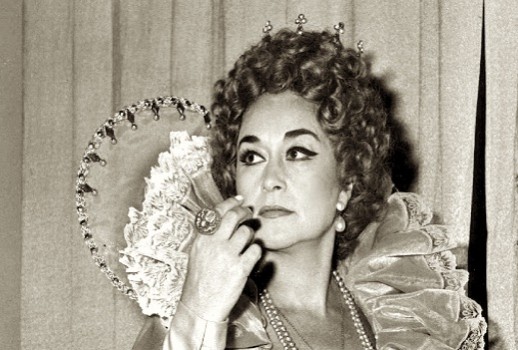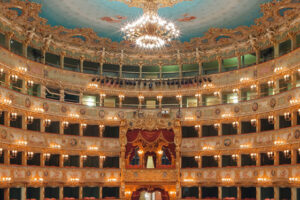

Nevertheless, Donizetti, who was known for his professional work ethic as well as being a kind and gentle man, found his recourse for survival through his music; in the process, he created in Roberto Devereux one of opera’s most vividly drawn, memorable characters—Queen Elizabeth I. It was not the first time the composer had dramatized the English monarch; in 1829 she was the subject of his early opera Il castello di Kenilworth, and in 1835 Elizabeth figured prominently—albeit characterized rather one dimensionally—in his Maria Stuarda.
Roberto Devereux was an immediate, highly-lauded success, and was performed over the next several decades worldwide. After the early 1880s, though, it was not given again until 1964, in Naples.
Devereux was adapted from a French play by Jacques Ancelot and converted into a libretto by Salvatore Cammarano, the librettist of Lucia di Lammermoor. In this treatment, Cammarano takes great liberties with history in order to construct a story that is, frankly, melodramatic, being imbued with traditional themes of fate. With its emphases on mistimed incidents and misplaced items (a scarf and a ring provide the catalyst for Roberto’s execution), its plot contrivances were typical in Romantic Italian opera of the day.
In spite of these dramatic clichés, Cammarano laid out a compelling drama where the emotions of the characters are vividly portrayed. In particular, Elizabeth herself is fleshed out into a fully human, complex personage who is torn between her duties as a queen, and her feelings as a woman in love.
Fortunately, the title character Roberto and the secondary leads, the Duke and Duchess (called Sara here) of Nottingham, are depicted by text and music of considerable merit, and which provides Elizabeth with much to feed off of, and to react against. Although Roberto, Sara and Nottingham have solos which do not reach the exalted level of Elizabeth’s, they are nonetheless finely hewn numbers which typify Donizettian lyricism.
Sara’s opening number, “All’aflitto, è dolce il pianto,” is a plaintive, melancholic cantabile melody which must have affected the young Verdi: he later adapted the tune in his defining choral piece “Va, pensiero,” from Nabucco. Nottingham’s “Forse in quel cor sensibile” is an introspective larghetto tune that is one of the celebrated arias of the baritone repertoire. Roberto’s “Come uno spirto angelico” is a suave cantabile aria of supreme grace and beauty, which gives the tenor an opportunity to shine.
The cabaletta that follows, “Bagnato il sen di lagrime,” which is marked as a rather chipper allegretto, is condemned by fastidious musicologists as being inappropriately sprightly and vulgar for the dramatic situation at hand. This view is perhaps based on scholarly snobbery and ignorance: Donizetti was a man of the theater, and good theater allows performers to entertain at multiple levels.
However, it is in the duets and ensembles that find these characters with their most powerful outlets of emotions and complexities of situations; in some crucial ways, these confrontations provide more illumination of musical conception and psychological depth than the isolated solos. In their duet in the first act, Roberto is recalcitrant and unyielding as Elizabeth tries to inveigle from him feelings which he no longer has toward her. The quick accompanying orchestral interlude signifying Roberto’s entrance reveals the queen’s agitated pulse in anticipation of his arrival.
At first brusque and demanding with Roberto, she melts in nostalgic recall as she intones, in a most caressing phrase, “Oh rimembranza,” which segues into a passage of the utmost loveliness, “Un tenero core,” that shows Elizabeth revealing her most tender, vulnerable feelings. Moments later, confused and goaded by his lack of response to her, she tries to intimidate Roberto into revealing that he is in love.
When he denies this—“Io? No,” the brief, crashing chord following this is like a verbal slap in the face to Elizabeth; the queen then responds, to a superb vivace passage , “Un lampo, un lampo orribile,” which shows the queen in her monumental, injured rage (the tune itself was again by borrowed by Verdi— in the trio that ends Act 1 of Il trovatore).
Later, Roberto, while no less troubled, is a different man altogether for his encounter with Sara, an uncommonly fine duet; here he shows the passions of a man in love that was missing in his scene with Elizabeth. Verdi once again found borrowing from Donizetti a felicitous notion in this duet. In the duet for tenor and soprano in Un ballo in maschera, the section “Non sai tu” uncannily recalls Sara and Roberto’s “Dacchè tornasti.”
Nottingham’s music, largely conventional in the typical betrayed-baritone vein, becomes vivid in the duet with his wife Sara in Act 3; “Più tremenda avvampa e rugge,” to Sara’s feverish protestations, has a towering sweep of vengeance that easily might parallel Rigoletto’s “Sì, vendetta.”
It is on Elizabeth, though, that Donizetti lavishes his most intense imagination and infinite care of conception. The role is one of the most difficult in the soprano repertoire, calling for a singing actress of the most superior technical and dramatic skills possible. In some ways Elizabeth is on the same exalted parallel with Bellini’s Norma in its exacting requirements and need for a virtuoso soprano of the highest order. Elizabeth’s music, of Donizetti’s Tudor Trilogy, is quite possibly the most difficult, replete with raging scale work passages, octave leaps, and much in the way of forceful, scalding declamation.
Her sovereign stature is immediately characterized at her entrance her entrance by flamboyant, yet decisive, brass-laden flourishes that establish her royal mien. Already by the end of the opening recitative we get a signature instance of how Elizabeth expresses her imperious rage: the phrase “la mia vendetta” vaults an octave’s scale. Moments later, though, we get our first glimpse into Elizabeth’s heart: “L’amor suo mi fe’ beata” is a deeply felt, larghetto piece of considerable beauty. It has a wistful poignancy that make us feel the queen’s pensive state.
The cabaletta that follows (“Ah! ritorna qual ti spero”) to our ears may sound inappropriately jaunty and undignified for a queen. Yet it reveals Elizabeth’s inner excitement and her private, heart-catching joy at the prospect of seeing Roberto again.
Act 2 is one of Donizetti’s most inspired, one that crackles with white-heat drama and tension, with Elizabeth’s fury and frustration reaching, seemingly, ever-higher heights of skillful means and imagination. Her responses to Nottingham (“Taci: pietade o grazia” and “Il tradimento orribile”) are characterized by treacherously difficult passages, with wide interval leaps that are beyond the skill of any but the most accomplished technician.
Upon Roberto’s entrance; Elizabeth scornfully taunts him with the bitterest of words (“Ecco l’indegno!”), then she goes for the plunging, knife-like assault *“Un perfido!”) and the following phrases brilliantly captured by repeated attacks on downward scalar passages. In nearly all instances here, Donizetti uses florid figurations to depict emotions, not as technical razzle-dazzle for purposes of display.
In the magisterial trio that follows for Elizabeth, Roberto and Nottingham (“Alma infida”), the queen seethes with formidable outrage. The signing of the death warrant (“Tutte udite”), with its sinister, accompanying maestro assai, is grave, tense, with the queen intractably determined; however, moments later, she loses her composure and explodes with malevolent, unbridled fury in the wide-ranging (across nearly two octaves) “Va, la morte,” ending the act with magnificently febrile excitement.
It is in the opera’s finale, though, where Donizetti fairly outdoes himself in inspiration, as he was perhaps never again to match. Here is where he seems to have transferred all of his life’s grief and pain through Elizabeth’s own. It is an electrifying, shockingly raw-emotioned scene which has few equals in its realm.
After a terse recitative in which Elizabeth declares her herself as “just a woman,” she launches into “Vivi ingrato,” an expansive, long-lined aria which manages to be both a gorgeous melody and a keen expression of torment, depicting most persuasively a profound weariness of soul. The word ‘m’abbandona’ is effectively varied throughout, each to different writing; the emotional climax comes when the word is intoned over a wide, gradual “sinking” sequence of notes, from top B down to nearly the octave below; its weary plunge indicates Elizabeth’s abject sense of futility.
After the fatal cannon shot is fired, we hear how Donizetti imparts the chorus’s fear, with an underlying, disquieting tension in anticipation of Elizabeth’s reaction; she splutters helplessly and vents her bitterness toward Sara and Nottingham.
As if what had proceeded were not enough, Donizetti caps the opera with a scene that has no precedent: “Quel sangue versato,” one of the most arresting set pieces in all opera. Marked by a grave maestoso in D major, it is a halting, pain-wracked soliloquy that features intervals of sevenths and tenths in the writing suggesting a kind of lunacy of despair.
It is here, perhaps, where Donizetti’s skills are forward-reaching: this piece has all the intensity, fatality and harshness of musico-psychological expression that was a feature, decades later, of Italian verismo. Much has been made of Elizabeth’s historically inaccurate closing words, in which she abdicates to James. Donizetti and Cammarano were not after historical accuracy: they were intent on producing a piece of effective theater conveying the gamut of personal human dramas.
In Roberto Devereux, they certainly succeeded: arguably, the Italianized, musically conceived queen is one of the most magnificently realized creations in all opera.
Fortunately, we now have our choice of numerous documents, both commercial and live, that offer valid realizations of the work.
Leyla Gencer (pictured) who sang the 20th century’s first performance of the opera (Napoli, 1964) is an arrestingly intense Elisabetta, complete with her trademark glottal attacks, brazen use of the lower register, and not always disciplined coloratura:
Montserrat Caballé introduced the opera to the U.S. in the 20th century for the first time (Carnegie Hall, 1965), and the feature her best, young-prime work. Caballé could be said to have the ideal voice for the role. Despite this, she had to simplify and rearrange many of the more demanding passages. Here she is from Aix, 1977, with the young José Carreras:
In 1970, Beverly Sills introduced Roberto Devereux for the first time in a staged production in the U.S. at the New York City Opera. I prefer her 1969 studio recording to the live document. While infinitely more intense and vivid, the “pirate” exposes Sills’ wiry upper register in declamatory passages. The studio affair has her in more congenial voice, and demonstrates her unerring florid singing, and accurate traversal of the score. However, the live performance at 2:05:28 boasts the most astonishing “double attack” high Ds ever:
Edita Gruberova sang Elisabetta in her first staged performance in Barcelona in 1990. In what is arguably her finest performance in the role, she has considerable upper range power, and the score is sung with assured accuracy.
Outstanding too is the blisteringly intense Elisabetta of Alexandrina Pendatchanska (now Alex Penda) in the 1998 Napoli performance. Reservations will center on Penda’s driven, heavy vibrato, and occasional rough passagework.
Mariella Devia, essaying the role for the first time in her 60s, reveals her incredible vocal longevity, as well as a newfound dramatic awareness, so different from her familiar “placid” quality.
Mariana Nicolesco, in a performance from Monte Carlo in 1992, offers much awareness and serviceable involvement, but her insecure technique and bleaty tone is a liability.
Raina Kabaivanska, at age 59 in 1993, displays her rather tough, hyper-dramatic Elisabetta. The size of her voice is marvelously effective, as is her intensity; however, bravura passages are severely compromised.
In a performance of the final scene from 2015, Anna Pirozzi may quite possibly be the closest thing to the Elisabetta Donizetti envisioned. Her singing is poised and powerful, and her declamation of the text crackles with authority.

























Comments